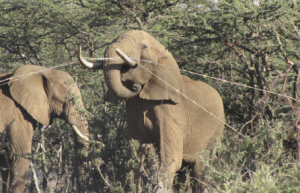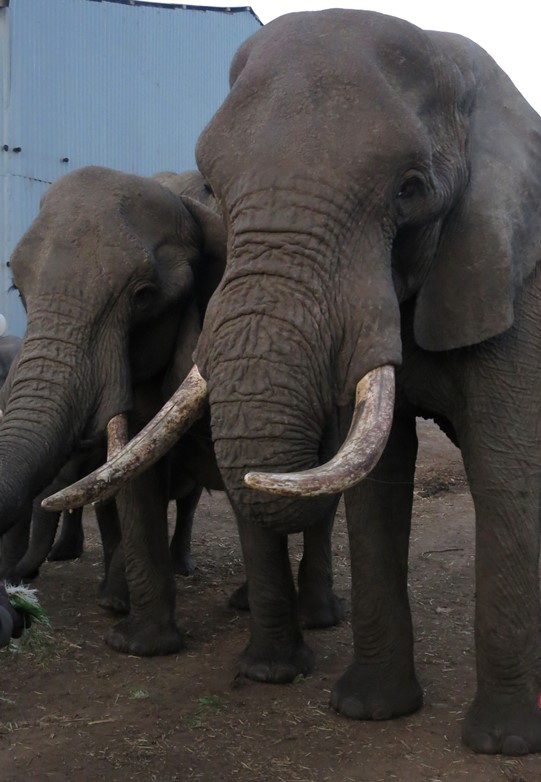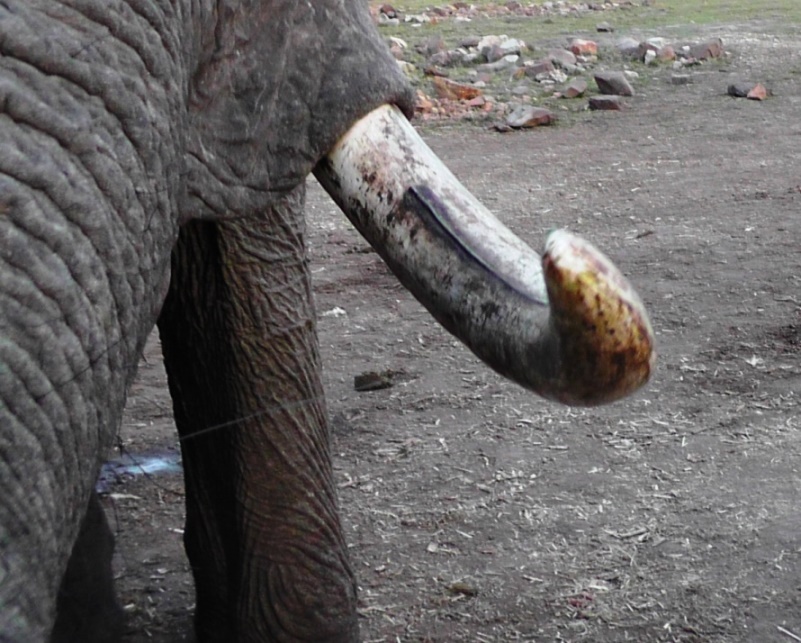- Fencing is increasingly used to separate humans and wildlife, but some elephants learn that their tusks do not conduct electricity and use them to break through even electric fences.
- To discourage further fence-breaking at one South African elephant sanctuary, a manager developed a “tusk brace,” a stiff wire glued into a small groove in each tusk that conducts the electricity from the tip to the more sensitive base beneath the animal’s lip.
- The braces reduced break-throughs by the repeat offenders, with no observable negative effects, though their use may be most appropriate with animals that are monitored regularly.
- As development expands into previously natural areas, keeping such fences maintained, for the safety of both people and elephants, may become an unfortunate necessity.
As agriculture expands into traditional elephant habitat, human-elephant conflict (HEC) has become a major threat to long-term survival of African (and Asian) elephants, often facilitating poaching and habitat destruction.
Governments and farmers determined to save their crops have traditionally used various deterrence methods—including noise-makers, catapults, rocks, fire, barriers, shooting to scare, electric fencing, and translocation of problem elephants—to mitigate this conflict. For a review of some of the many approaches used to reduce HEC, see here and here, or consult the references below.

Electric fences, while costly to build and maintain, have—more than most other approaches—been shown to reduce HEC since they successfully separate people and elephants. When maintained, they are an effective wildlife management and conservation tool. Nonetheless, some elephants learn that their tusks do not conduct electricity. Fence-breaking elephants learn to use their tusks to pull wires up and down to break through electric fences, which brings them into contact with people, potentially causing danger to both sides.
In a novel use of some basic tools to help maintain costly electric fencing around reserves or farms, Alexander Vipond of the Knysna Elephant Park in South Africa invented a simple device, nicknamed “tusk braces,” to discourage elephants from cutting fence wires.
Mongabay-Wildtech asked Vipond about the inspiration for the tusk braces and their implementation and combined his on-the-ground experience with that of other HEC efforts for this article.
- Where did he get the idea for tusk braces?
Electric fences are used in South Africa’s sanctuaries and private game reserves to keep people and elephants apart. Vipond’s idea for the wire came from a lot of time with elephants in large but enclosed areas, including with one beloved young male called Harry that had learned to break the area’s electric fence.

Electric fences have had success in minimizing human-elephant conflict, so long as they are maintained, but elephants that destroy fence wire can then also enable other elephants to pass through the fences into neighboring lands and villages. Elephants that destroy crops or property are unfortunately in danger of retaliation from angry farmers.
To protect both people and elephants such as Harry, Vipond wondered how he could possibly get him to stop breaking fences. More specifically, he asked, “How can I make Harry’s tusk into a conductor?”
- How did he come up with the groove in the tusk?
Years before, Vipond had attended the elephant management training course at Riddle’s Elephant and Wildlife Sanctuary in Arkansas, USA, which teaches “old-school” elephant care and husbandry and “showed me the basics of what was required to keep an elephant, for lack of a better word, manageable.” While his own management approach is not “old-school,” his experience gave him an idea. The facility used a special device when it needed to move elephants from place to place. The device, made with a stainless steel band, like a hose clamp, mounted on the front of the tusks and connected to the floor, kept the elephants from hurting each other with their tusks while in transit.
The bands were more solid than a wire, but his designs with large pipe clamps would loosen over time, as tusks are tapered, rounded, and slick. In brainstorming a method to stop fence-breaking, Vipond wondered, “What if I could put a groove in the tusk from the elephant’s lip to the tip of his tusk that could carry the current to where he would feel it?”
- What exactly are tusk braces and how did he put them on an elephant?
The tusk brace is basically a wire fit onto the length of the top of the tusk, like human braces. Vipond used a 3mm rustproof high-tensile wire that is stiff and bent to contour to the individual tusk. To keep it flush with the surface of the tusk, the team used a drill to cut a groove in the tusk just slightly (<1mm) deeper than the wire.
Using tools and fitting an elephant, even a domesticated one, with a tusk brace wire requires some sort of sedation. It also requires care and attention to detail. Most of the tusk is solid and lacks sensation, but where the tusk meets the animal’s lip, it is still thick but has a hollow interior. Vipond emphasized the care needed when drilling the tusk at that point to reduce any risk of damage.
The team held the wire in the groove with adhesive (a set of two epoxy glues mixed together from South Africa’s Pratley company hardened quickly and lasted the longest). A minimal amount of adhesive is important for holding the wire most securely–too much was less secure.

- How does it help stop fence-breaking?
The bulk of the tusk does not conduct electricity. Fence-breaking elephants have learned this and will pull and push the wires of an electric fence with the tops of their tusks until the wires snap. A wire fitted into a groove along the edge of each tusk can conduct electricity from the end of the tusk, which lacks sensation, to just before it meets the lip, which is more sensitive. While not dangerous, an electric fence meant to control elephant movements gives a strong shock that the animals logically want to avoid.
- How effective were the braces in discouraging fence breaking? Did the elephants lose the habit?
Of the two elephants that have been fitted with tusk braces by Vipond and his colleagues, both stopped breaking fences. Harry learned that his tusks were no longer effective and stopped breaking fences through to the present.
Shaka, the other elephant with tusk braces, initially stopped breaking fences but then learned he could still use the bottom of his tusks safely to cut through the fences. Alex described Shaka as “a very busy elephant–pushing trees, debarking trees, digging, etc–and eventually his wire came off the tip, so the team pulled it out and replaced it with another.

- How long do they stay in place? What happens when the tusk grows?
It seems to be a mix. Shaka’s wire had to be replaced, and one of Harry’s two tusk brace wires also came off. Harry’s other wire is still in place, five years after they were first put in.
Tusks are large teeth, with nerve endings in the center of the upper portion. As the tusk grows, however, the inlaid wire moves farther and farther from the lip and stops carrying the current to sensitive tissue. Vipond therefore stressed that the wire needs to reach as far up on the tusk as possible.
- Where else is this technique being used?
Vipond doesn’t know if anyone else has used the technology, though a local veterinarian phoned and asked whether there was a way to stop elephants from raiding, so Vipond sent him photos of the tusk braces.
Lewa Wildlife Conservancy in Kenya had a similar problem and trimmed off 2/3 of the tusks of four habitual fence-breakers there. This dramatically slowed fence-breaking, though these four bulls turned to other, less effective ways to get through the fence. However, it prompted critical ethical and ecological questions about an elephant’s need for tusks to dig for minerals, strip bark, maintain reproductive status and generally look like a normal elephant.

- Does he see any downside? Would he recommend it to other sanctuaries, reserves or other places where elephants break fences?
When asked if he would recommend the setup to other managers, Vipond thought it could be helpful for facilities with domesticated or habituated elephants that can be monitored regularly. Vipond was concerned that if the wire got loose on a wild elephant from digging or stripping bark, it might not be found and could injure the animal. For the same reason, he added that elephants living in open grasslands might be better candidates than those in rougher terrain with denser bushes.

No single mitigation strategy has eliminated human-elephant conflict. Relatively few elephants break fences, but some are repeat offenders. The tusk brace is one of several novel strategies aimed to address a large and growing challenge for elephant conservation and human development.
Researchers have developed and tested ideas such as chili fences, beehive fences, and drones to help reduce HEC, and controlling elephant movements through electric fencing is already an unfortunate reality, even in many large landscapes. As more managers must rely on fencing of either reserves or neighboring farms to separate elephants and humans for the safety of both, the need to keep the fences maintained efficiently increasingly greater.
References and reviews of human-elephant conflict (HEC) reduction lessons
Bouché P, Douglas-Hamilton I, Wittemyer G, Nianogo AJ, Doucet JL, et al. (2011) Will elephants soon disappear from West African Savannahs? PLoS ONE 6: e20619.
Graham MD, Gichohi N, Kamau F, Aike G, Craig B, et al.. (2009) The Use of Electrified Fences to Reduce Human Elephant Conflict: A Case Study of the Ol Pejeta Conservancy, Laikipia District, Kenya, Working Paper 1, Laikipia Elephant Project, Nanyuki, Kenya.
Hahn, N., Mwakatobe, A., Konuche, J., de Souza, N., Keyyu, J., Goss, M., Chang’a, A., Palminteri, S., Dinerstein, E. and Olson, D., 2016. Unmanned aerial vehicles mitigate human–elephant conflict on the borders of Tanzanian Parks: a case study. Oryx, pp.1-4.
Hedges S, Gunaryadi D (2010) Reducing human–elephant conflict: do chillies help deter elephants from entering crop fields?. Oryx 44: 139–146.
Hoare, R., 2015. Lessons from 20 years of human–elephant conflict mitigation in Africa. Human Dimensions of Wildlife, 20(4), pp.289-295.
Jenkins PR, Hamilton PH (1982) The Laikipia Elephant Problem. Wildlife Conservation and Management Department, Ministry of Tourism and Wildlife, Nairobi.
King LE, Douglas-Hamilton I, Vollrath F (2011) Beehive fences as effective deterrents for crop-raiding elephants: field trials in northern Kenya. Afr J Ecol 49: 431–439.
Kioko J, Muruthi P, Omondi P, Chiyo PI (2008) The performance of electric fences as elephant barriers in Amboseli, Kenya. S Afr J Wildl Res 38: 52–58.
Loarie SR, van Aarde RJ, Pimm SL (2009) Fences and artificial water affect African savannah elephant movement patterns. Biol Conserv 142: 2086–3098.
Mijele D, Obanda V, Omondi P, Soriguer RC, Gakuya F, et al. (2013) Spatio-temporal distribution of injured elephants in Masai Mara and the putative negative and positive roles of the local community. PLoS ONE 8: e71179.
Mutinda M, Chenge G, Gakuya F, Otiende M, Omondi P, Kasiki S, et al. (2014) Detusking Fence-Breaker Elephants as an Approach in Human-Elephant Conflict Mitigation. PLoS ONE 9: e91749. https://doi.org/10.1371/journal.pone.0091749
Nelson A, Bidwell P, Sillero-Zubiri C (2003) A review of human-elephant conflict management strategies. People & Wildlife, A Wildlife Conservation Research Unit, Born Free Foundation Partnership.
Osborn FV, Parker GE (2003) Towards an integrated approach for reducing the conflict between elephants and people: a review of current research. Oryx 37: 80-84.
Oswin Perera BMA (2009) The human-elephant conflict: a review of current status and mitigation methods. Gajah 30: 41–52.